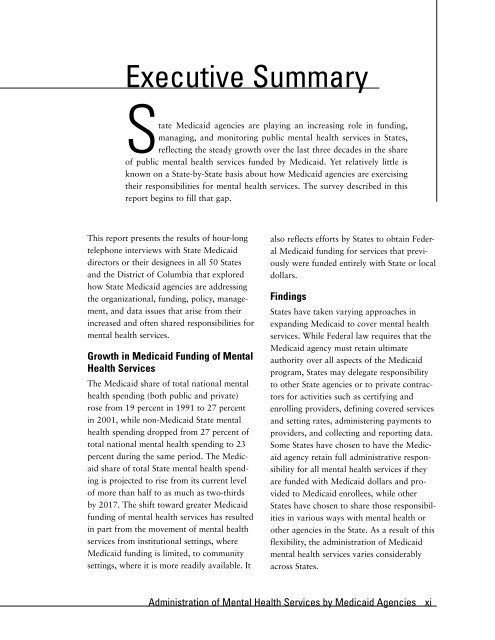Administration of Mental Health Services by Medicaid Agencies
Administration of Mental Health Services by Medicaid Agencies
Administration of Mental Health Services by Medicaid Agencies
You also want an ePaper? Increase the reach of your titles
YUMPU automatically turns print PDFs into web optimized ePapers that Google loves.
Executive SummaryState <strong>Medicaid</strong> agencies are playing an increasing role in funding,managing, and monitoring public mental health services in States,reflecting the steady growth over the last three decades in the share<strong>of</strong> public mental health services funded <strong>by</strong> <strong>Medicaid</strong>. Yet relatively little isknown on a State-<strong>by</strong>-State basis about how <strong>Medicaid</strong> agencies are exercisingtheir responsibilities for mental health services. The survey described in thisreport begins to fill that gap.This report presents the results <strong>of</strong> hour-longtelephone interviews with State <strong>Medicaid</strong>directors or their designees in all 50 Statesand the District <strong>of</strong> Columbia that exploredhow State <strong>Medicaid</strong> agencies are addressingthe organizational, funding, policy, management,and data issues that arise from theirincreased and <strong>of</strong>ten shared responsibilities formental health services.Growth in <strong>Medicaid</strong> Funding <strong>of</strong> <strong>Mental</strong><strong>Health</strong> <strong>Services</strong>The <strong>Medicaid</strong> share <strong>of</strong> total national mentalhealth spending (both public and private)rose from 19 percent in 1991 to 27 percentin 2001, while non-<strong>Medicaid</strong> State mentalhealth spending dropped from 27 percent <strong>of</strong>total national mental health spending to 23percent during the same period. The <strong>Medicaid</strong>share <strong>of</strong> total State mental health spendingis projected to rise from its current level<strong>of</strong> more than half to as much as two-thirds<strong>by</strong> 2017. The shift toward greater <strong>Medicaid</strong>funding <strong>of</strong> mental health services has resultedin part from the movement <strong>of</strong> mental healthservices from institutional settings, where<strong>Medicaid</strong> funding is limited, to communitysettings, where it is more readily available. Italso reflects efforts <strong>by</strong> States to obtain Federal<strong>Medicaid</strong> funding for services that previouslywere funded entirely with State or localdollars.FindingsStates have taken varying approaches inexpanding <strong>Medicaid</strong> to cover mental healthservices. While Federal law requires that the<strong>Medicaid</strong> agency must retain ultimateauthority over all aspects <strong>of</strong> the <strong>Medicaid</strong>program, States may delegate responsibilityto other State agencies or to private contractorsfor activities such as certifying andenrolling providers, defining covered servicesand setting rates, administering payments toproviders, and collecting and reporting data.Some States have chosen to have the <strong>Medicaid</strong>agency retain full administrative responsibilityfor all mental health services if theyare funded with <strong>Medicaid</strong> dollars and providedto <strong>Medicaid</strong> enrollees, while otherStates have chosen to share those responsibilitiesin various ways with mental health orother agencies in the State. As a result <strong>of</strong> thisflexibility, the administration <strong>of</strong> <strong>Medicaid</strong>mental health services varies considerablyacross States.<strong>Administration</strong> <strong>of</strong> <strong>Mental</strong> <strong>Health</strong> <strong>Services</strong> <strong>by</strong> <strong>Medicaid</strong> <strong>Agencies</strong> xi
















